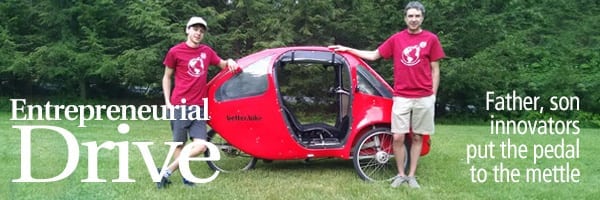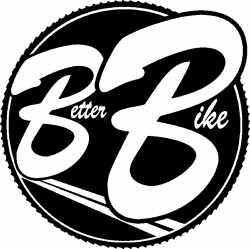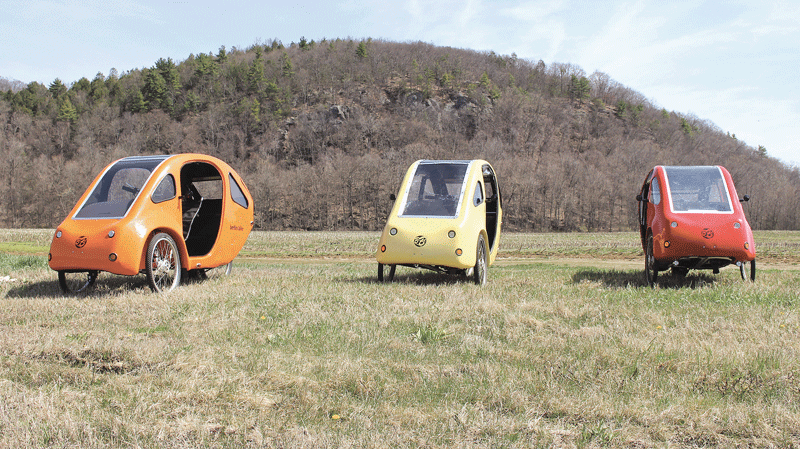
Father, Son Innovators Put the Pedal to the Mettle
Entrepreneurial Drive

Kevin, left, and Devin Murray, the father-and-son co-founders of better.bike.
It was born out of a blend of need and desire. Nevin Murrary wanted something that would get him to high school in a manner that would by healthy, environmentally friendly — and cool. He and his father, Kevin, came up with the PEBL, described as a bridge between a bike and a car. But beyond becoming an effective means for the younger Murray to commute, it is evolving into a business concept with recognized potential.
When Nevin Murray arrives at Greenfield Community College in September, he’ll do so with most of the usual questions and anxieties that most all entering freshmen have. Well … maybe not; he certainly has a lot of poise and confidence for an 18-year-old, and with good reason, as we’ll see in a bit.
One thing’s for certain, though. His arrival will be totally unique in one aspect: he’ll be driving something no one else on that campus (or any other campus, for that matter) has — a PEBL.
That’s technically still an acronym (it stands for Pedal Electric Bike Lifestyle), but Nevin and his father, Kevin, who together conceptualized, designed, built, and soon plan to manufacture this vehicle, consider it more of a model name than anything else.
As one discusses it, the word ‘vehicle’ is certainly the safest term you can use. But it’s not a car, although it looks like one (sort of, anyway), especially the tiny Smart cars now gaining traction in this country. And it is not technically a bicycle in the strictest sense of the word, although the name the Murrays have chosen for their enterprise is better.bike, which uses the tag line ‘Solutions in Transportation,’ which is quite effective and totally accurate (more on why later).
No, this product is a ‘velomobile.’ That’s a technical term in transportation circles, and one that’s been around for a least a century, by most estimates. It is used to describe, well, a bicycle/car, or a bicycle that is enclosed for aerodynamic advantage and protection from the weather. In those respects, the PEBL is not really unique. But in many others, it certainly is — from the material used to make the body (it’s actually a hemp-and-soy composite, rather than fiberglass) to the lithium-ion battery-powered motor.
In other words, the PEBL is both eco-friendly and human-friendly, said Kevin, an acupuncturist by trade, noting that, in his estimation, fiberglass is one of the most toxic substances used in manufacturing today.
“One of my passions is looking after people’s health,” he said, adding that this mindset explains many aspects of the PEBL, from its conception to the component materials used in making it.
The Murrays say their vehicle was born from need and desire — for a four-season velomobile that could handle the rigors of a Western Mass. winter — and came together over three years of searching junkyards for parts, trial and error, and the maturation of an innovative streak that both men possess.
 The same goes for another trait — entrepreneurship, although the two acknowledged they had a lot to learn about the difficult process of transforming an idea into a business. With that in mind, they applied to become part of Valley Venture Mentors’ second accelerator class, and were accepted.
The same goes for another trait — entrepreneurship, although the two acknowledged they had a lot to learn about the difficult process of transforming an idea into a business. With that in mind, they applied to become part of Valley Venture Mentors’ second accelerator class, and were accepted.
They didn’t make the list of finalists — honored at ceremonies last week — and thus didn’t win one of the larger monetary prizes distributed to those chosen 12. They both say they came away with something inherently more important, though — invaluable insight into maneuvering the many forms of whitewater facing startups, from identifying potential markets to raising the capital needed to advance the concept.
For this issue, BusinessWest continues its recent efforts to spotlight emerging startups across the region by talking with the Murrays about their concept and why they believe it can be a vehicle for business success, figuratively and quite literally.
Putting the Wheels in Motion
The senior class at Amherst Regional High School recently voted on a number of the usual honors presented at this time of year — to individuals of both sexes deemed the most popular, most likely to succeed, best dressed … the list goes on.
There’s one for ‘best car’ as well. One young woman earned the prize for the Mercedes she parks every morning, while Nevin Murray took the honor with his red PEBL, the second prototype built by the father/son team, which he has been driving for about a year now, and with a purpose.
“I’ve been testing every possible aspect of it,” he explained, “to make sure that we’ve covered everything we need to cover.”
He knows this is technically not a car, but he’s not about to give his award back; he’s rather proud of it. But he and his father are soon hoping their concept will win much more — specifically the attention of the buying public, or at least a decent-sized component of it.
This would be the segment (or segments) that care about the environment, and themselves, and want a healthy alternative, or solution (there’s that word again), for their transportation needs.
Right now, though, the Murrays are also hoping to win some financial support. Indeed, a Kickstarter campaign is being planned — one that seeks to net at least $50,000 for a mold and tools that will help get production of the vehicles off the ground.
Kevin told BusinessWest that the company is currently searching for manufacturing space, preferably in the Deerfield area, and needs about 2,000 square feet to get started. It took months to build each of the first few prototypes, he went on, but the process has been refined and formalized, and a team can now assemble one in a day or two. They expect that people who want a PEBL can get one as soon as this fall.
Before looking toward the immediate and long-term future, though, this would be a good time to go backward — something else the PEBL can do that a bike can’t — and look at how we arrived here.
Our story begins in the summer of 2013, said Kevin, who started by noting that, while his career has been in healthcare, he minored in engineering in college and has always enjoyed working with his hands and building things — character traits passed down to Nevin.
“Since he could pick up Legos, he’s been a builder,” he said of Nevin, adding that the two have collaborated on many initiatives. “We’ve been in science fairs and all kinds of projects, each one more complex.”
When Nevin turned 15, he went on, conversations within the family began to include talk about how the then-high-school student could, or should, get around. “We didn’t want to get a third car — we’re a very environmentally conscious family, and Nevin is even more so — so we started hunting around for a different kind of alternative vehicle for him that would hopefully include bicycling.”
The two saw some things online that caught their attention, but nothing effectively checked all the boxes they wanted to check. So they decided to design and build something that would.
“We wanted something he could use all year-round,” Kevin explained, “and also something where he wouldn’t be all sweaty when he got to school — we live seven miles from the high school — and that looked cool.”
The process of coming up with something that did all that started with visits to the nearest Home Depot and several area junkyards, said Nevin, adding that, as the concept starting coming together, they eventually realized it had potential as a marketable product, and this realization prompted a far more serious approach to their R&D.
“After we built the first prototype, we realized that to refine it enough to be a product wouldn’t take much more work,” he explained. “From there, it was a year of materials research and figuring out what goes where.”
What they pieced together — quite literally — is something that bridges the gap between a bike and a car. It has a 750-watt motor, powered by a 48-volt, 16-amp lithium-ion battery that on flat roads provides up to 30 miles of continuous riding without using the pedals. (Users can buy additional batteries for longer trips.)

The Murrays say that is all goes well, consumers should be able to get their own PEBL this fall.
As for those pedals, PEBL owners can use them for short stretches, but the vehicle weighs 200 pounds or so, meaning one wouldn’t want to pedal uphill or very far. There’s an electric heater to keep the user warm in winter, and the doors come off to create air flow in the summer. The PEBL (sticker price $6,000) can accomodate a rider well over six feet tall, and even has the ability to tow a bicycle.
A license is not required to drive one, and the vehicles themselves are not registered, said Kevin, adding that he keeps expecting to get pulled over by the police while he’s out driving in his PEBL, the first prototype, but hasn’t yet.
While many of those features listed above are unique to one level or another, what makes the PEBL stand alone among vehicles like it is the materials used to assemble it.
“We spent hundreds of hours experimenting and researching different materials,” said Kevin. “We finally developed a combination of hemp cloth, instead of fiberglass cloth, combined with a non-toxic epoxy that’s made from soy and peanut oil.”
These materials, as he noted earlier, are safer for those doing the assembly — one doesn’t need to wear a respirator. But they are also more practical. “We feel they make for a better body for the vehicle,” he explained. “It’s not as brittle as traditional fiberglass.”
Getting Up to Speed
As one reads the list of standard features on the PEBL, one would think it might be for a Honda Civic or even one of the myriad crossovers now flooding the market: ‘expandable cargo space,’ ‘cruise control,’ ‘standard rear suspension, ‘great visibility,’ among others.
It’s the lines at the top of that list, though, that make it readily apparent that this is not a car, or anything else currently on the road: ‘zero emissions,’ ‘pedal and electric,’ ‘hemp-and-soy composite body,’ ‘20 miles per hour top speed,’ ‘removable and stowable doors.’
It is the sum of all the items on that list that the Murrays believe will propel them to success with their venture — a vehicle that is in many ways practical, but also environmentally friendly and, if you get some pedaling in, good exercise.
They believe this product will play in cities and regions populated with individuals who value such things — and that have what they would consider a PEBL-friendly infrastructure. That would largely rule out New York, said Kevin, noting that residents would still have to find parking, which is always a struggle.
But he listed mid-sized, spacious cities such as Portland, Ore., Seattle (especially the sprawling tech-industry campuses there like Microsoft and Amazon), Denver, Austin, San Antonio, and others, as well as most all rural regions, as ideal for their concept. He believes there would be a strong market in Europe, where gas is very expensive, as well.
With an eye toward sharpening their focus on a target audience — and the many other aspects of making their PEBL company a reality — the Murrays sought to become members of VVM’s second accelerator class, were accepted, and found the experience invaluable.
It included use of the so-called ‘Lean Canvas’ to form a business plan, a one-pager that entrepreneurs can use to identify everything from the specific problem they’re trying to solve with their product or service to its unique value proposition; from channels for getting the product to consumers to a list of customer segments.
In the case of those customers, the team at better.bike identified several, including retired individuals, those with physical or fitness limitations, tech-loving Millenials, a parent with one or two small children, and commuters who want to ride in all seasons and all weather. Similarly, for early adopters of this concept, they identified these groups: those who care about the environment, individuals who want to get exercise, those who want to commute or ride in “something that is fun and looks cool,” and people put off by the expenses associated with using a car.
As they talked about the VVM experience, the Murrays used language similar to other participants.
“It was a real kick in the pants,” said Kevin. “It really moved us — it forced us to move quickly and focus. It put us in touch with reality.
‘From the beginning, they said, ‘don’t focus on the prize money, focus on the information and the connections that you’re going to get out of this,’” he went on, adding that they’ve done just that.
Nevin agreed, noting that the process of moving from product conceptualization to starting a company to market that product has been a learning experience on many levels.
“Getting the company going was definitely the most stressful part of this, but it’s also the one I’ve most enjoyed,” he said, adding that the experience has provided lessons in not only business, but life.
“As a teenager, I’ve been growing up as this has been happening,” he explained. “This has definitely shaped my perspective, especially on how I approach things and how I’m going to approach college. This experience has given me a better picture of how an idea transforms into an actual thing. And you can apply that to other things.”
The Ride Stuff
Nevin Murray, who plans to build one of those so-called ‘tiny houses,’ find a plot of land to put it on in Montague, and commute from there to GCC, told BusinessWest that he’s not sure where he’s going to park his PEBL on campus.
He said the school has a few spaces equipped with charging stations, but he’s not sure he wants to — or is even qualified to — take one of those. Wherever it’s parked, though, his velomobile is sure to turn some heads, as it has everywhere else it has appeared.
Whether it evolves into a decent-selling product that becomes part of the landscape in this region or those cities listed earlier remains to be seen. But what is certain is that this father-son team has no shortage of entrepreneurial drive, which should, like the PEBL itself, take them where they want to go.
George O’Brien can be reached at [email protected]




